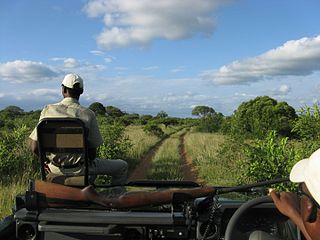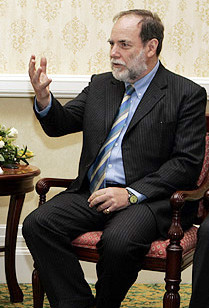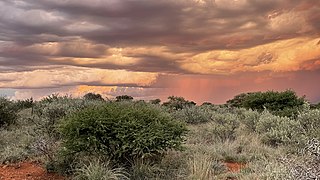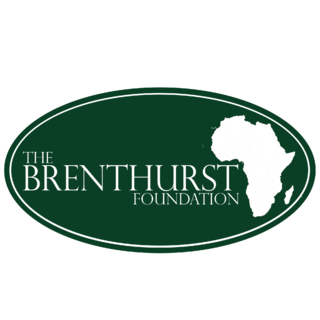
The Tswalu Kalahari Reserve is a privately owned game reserve in the Northern Cape, South Africa. It is South Africa's largest private game reserve, covering an area of over 111,000 hectares. [1]

The Tswalu Kalahari Reserve is a privately owned game reserve in the Northern Cape, South Africa. It is South Africa's largest private game reserve, covering an area of over 111,000 hectares. [1]
The Tswalu Game Reserve in the Southern Kalahari was created by Stephen Boler. He bought dozens of farms to create a conservation reserve, introducing African wildlife back into their natural habitat, including lions, rare types of antelope, giraffes, buffalos, and zebras. The reserve is home to the world's largest population of black rhinos. [2] To control the numbers and create a form or revenue to support the estate, there was a controversial hunting side called Tarkuni. After Stephen Boler's untimely death in 1998 on his way to Tswalu, he specified in his will that Nicky Oppenheimer should have first refusal on Tswalu, and the Oppenheimer family now owns and operates it.
Hunting was stopped by the Oppenheimers and some man-made structures, farm buildings and fences were removed. New land was added to extend and protect habitats and territories. Tswalu now holds the largest population of black rhino alongside other threatened species like the pangolin and canid African wild dog. [3]
Tswalu Kalahari is a luxury private lodge [4] in the reserve, a member of National Geographic Unique Lodges of the World. There are nine suites at the Motse Lodge, with the private Tarkuni having five suites.
The reserve boasts four of the 'big five', the exception being elephant.
Tswalu Kalahari reserve is part of the Diamond Route. [5] The conservation work of Nicky and Strilli Oppenheimer was recognized with the WWF-Lonmin Award from the World Wide Fund for Nature in 2007.

Kruger National Park is a South African National Park and one of the largest game reserves in Africa. It covers an area of 19,623 km2 (7,576 sq mi) in the provinces of Limpopo and Mpumalanga in northeastern South Africa, and extends 360 km (220 mi) from north to south and 65 km (40 mi) from east to west. The administrative headquarters are in Skukuza. Areas of the park were first protected by the government of the South African Republic in 1898, and it became South Africa's first national park in 1926.

Phinda Private Game Reserve, formerly known as Phinda Resource Reserve, is a 170 km2 (66 sq mi) private game reserve situated in KwaZulu-Natal, South Africa, between the Mkuze Game Reserve and the Greater St. Lucia Wetland Park. Designated in 1990, Phinda is derived from a Zulu phrase "Phinda Izilwane" meaning 'return of wildlife', or more accurately 'do again'.

Nicholas F. Oppenheimer is a South African billionaire businessman. He was formerly the chairman of De Beers diamond mining company and of its subsidiary, the Diamond Trading Company, and former deputy chairman of Anglo American. He is the third richest man in Africa.

Akagera National Park is a protected area in eastern Rwanda covering 1,122 km2 (433 sq mi) along the international border with Tanzania. It was founded in 1934 and includes savannah, montane and swamp habitats. The park is named for the Kagera River which flows along its eastern boundary feeding into Lake Ihema and several smaller lakes. The complex system of lakes and linking papyrus swamps makes up over a third of the park, which is the largest protected wetland in Eastern-Central Africa.

Trophy hunting is a form of hunting for sport in which parts of the hunted wild animals are kept and displayed as trophies. The animal being targeted, known as the "game", is typically a mature male specimen from a popular species of collectable interests, usually of large sizes, holding impressive horns/antlers or magnificent furs/manes. Most trophies consist of only select parts of the animal, which are prepared for display by a taxidermist. The parts most commonly kept vary by species, but often include head, skin/hide, tusks, horns, and/or antlers.

The Madikwe Game Reserve is a protected area in South Africa, part of the latest park developments in the country. Named after the Madikwe or Marico River, on whose basin it is located, it was opened in 1991 and comprises 750 km² of bushland north of the small town Groot-Marico up to the Botswana border.

Moremi Game Reserve is a protected area in Botswana. It lies on the eastern side of the Okavango Delta and was named after Chief Moremi of the BaTawana tribe. Moremi was designated as a game reserve, rather than a national park, when it was created. This designation meant that the BaSarwa or Bushmen that lived there were allowed to stay in the reserve.

The wildlife of Botswana refers to the flora and fauna of this country. Botswana is around 90% covered in savanna, varying from shrub savanna in the southwest in the dry areas to tree savanna consisting of trees and grass in the wetter areas. Even under the hot conditions of the Kalahari Desert, many species survive; in fact the country has more than 2500 species of plants and 650 species of trees. Vegetation and its wild fruits are also extremely important to rural populations living in the desert and are the principal source of food, fuel and medicine for many inhabitants.

Mokala National Park is a reserve established in the Plooysburg area south-west of Kimberley in the Northern Cape, South Africa on 19 June 2007. The size of the park is 26,485 hectares. Mokala is the Setswana name for the magnificent camel thorn, a tree species typical of the arid western interior and common in the area. There is currently 70 km of accessible roads in the national park.

Botswana's principal tourist attractions are its game reserves, with hunting and photographic safaris available. Other attractions include the Okavango Delta region, which during the rainy season is a maze of waterways, islands, and lakes. The tourism industry also helped to diversify Botswana's economy from traditional sources such as diamonds and beef and created 23,000 jobs in 2005.

The Brenthurst Foundation is a Johannesburg-based think-tank established by the Oppenheimer family in 2004 to support the Brenthurst Initiative in seeking ways to fund African development and to organize conferences on African competitiveness.
Atherstone Nature Reserve, also known as the Atherstone Collaborative Nature Reserve, is a 23,500 hectare reserve situated close to Dwaalboom, in the Limpopo, province in South Africa. The reserve consists mainly of vast savannah plains with bushveld and Kalahari grasslands ecosystems. Besides antelopes, zebras and giraffes, the black rhino and elephants are one of the highlights of Atherstone.

Angolan mopane woodlands are situated in southwestern Angola, extending into northern Namibia. This ecosystem surrounds Etosha Pan, which is considered a separate ecoregion. The mopane trees are the main type of vegetation.
Solio Ranch or Solio Game Reserve is a privately owned wildlife conservancy located in Kenya's Central Province.
Stephen Eckersley Boler was an English entrepreneur who founded a business dynasty and in later life became a conservationist in South Africa.
Erindi Private Game Reserve is a protected wildlife and ecological reserve in Namibia, southeast of the city of Omaruru. It is a private, fenced reserve located on the Namibian central plateau, populated with semi-open bush savannah and sparse, rugged mountains. The land on which Erindi was founded, has been reclaimed as part of a massive rehabilitation and conservation venture. The owners, Chris Joubert, and his brother Gert Joubert, originally bought the 70,719 hectares of land with the intention of going into cattle farming. It was soon realized that farming cattle is an extremely costly practice, and they abandoned the idea in favor of a private game reserve. The resulting aim was to restore endemic species to the area, with the intention that they would once again thrive there, and an ecotourism lodge and safari business would be built to provide income from the land.

Mudumu is a National Park in Caprivi Region in north-eastern Namibia. The park was established in 1990. It covers an area of 737 square kilometres (285 sq mi). The Kwando River forms the western border with Botswana. Various communal area conservancies and community forests surround Mudumu National Park.
Jonathan M. E. Oppenheimer is a South African billionaire businessman and conservationist, and the Executive Chairman of Oppenheimer Generations, a former executive of De Beers and a former vice-president of his family's firm, Anglo American Corporation.

Khama Rhino Sanctuary is a community based wildlife project in Botswana. The animal shelter was established in 1992 to assist in saving the vanishing rhinoceros, restore the historic wildlife populations and provide economic benefits to the local Botswana community through tourism and the sustainable use of natural resources. Covering approximately 8585 hectares of Kalahari Sandveld, the sanctuary provides prime habitat for white and black rhinos as well as over 30 other animal species and more than 230 species of birds.
WildEarth is a British-South African broadcasting and conservation company primarily based at Djuma Game Reserve, part of the Sabi Sand Game Reserve in South Africa, who focus on connecting people with African Wildlife. The company is best known for its live drives, which take place twice a day in Sabi Sands and Pridelands. Former locations included Tswalu Kalahari, Karongwe Private Game Reserve, Phinda, Ngala and Arathusa.
![]() Media related to Tswalu Kalahari Reserve at Wikimedia Commons Coordinates: 27°14′35″S22°24′18″E / 27.24306°S 22.40500°E
Media related to Tswalu Kalahari Reserve at Wikimedia Commons Coordinates: 27°14′35″S22°24′18″E / 27.24306°S 22.40500°E